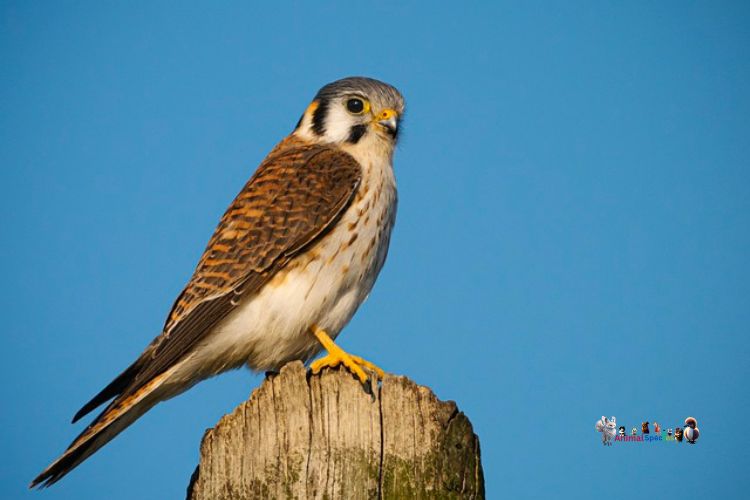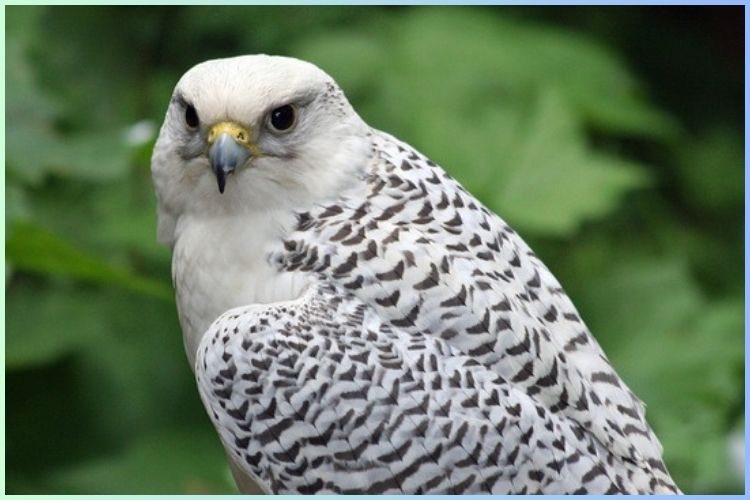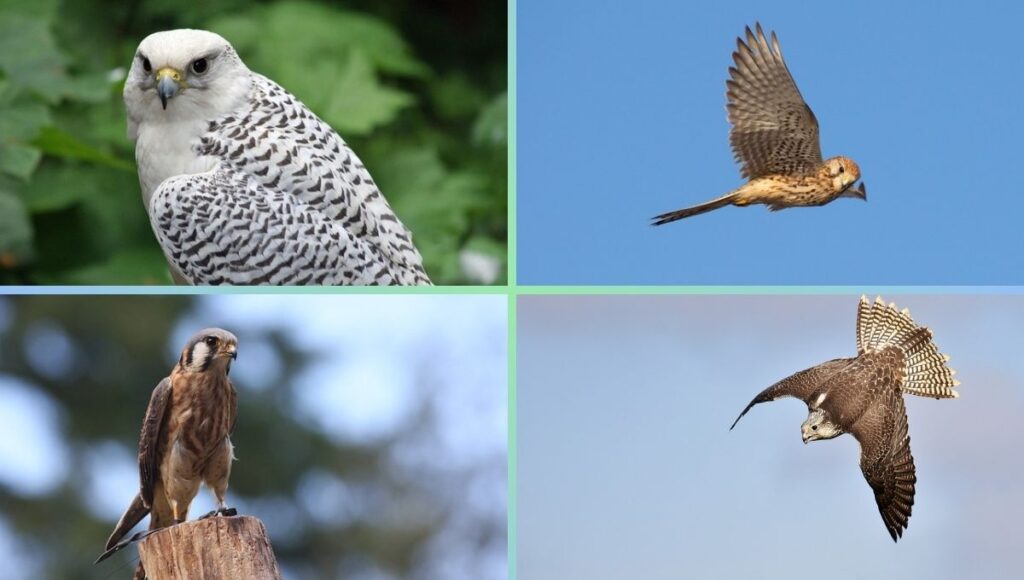Discover the 4 species of falcons in Alaska in 2024. Here are the 4 types of falcons that live in Alaska: American Kestrel, Merlin, Peregrine Falcon, and Gyrfalcon.
American Kestrel in Alaska

American Kestrel is the common species of falcons in Alaska in 2024. This species of birds can grow up to 7 to 12 inches long with a wingspan of 24 inches.
| Fact | Details |
|---|---|
| Smallest Falcon | American Kestrels are the smallest falcons in North America. |
| Where They Live | They live in open fields, meadows, and along forest edges in Alaska. |
| What They Look Like | They have reddish-brown feathers, a spotted chest, and dark facial markings. |
| What They Eat | They hunt insects, small mammals, and birds. |
| Where They Nest | They nest in tree cavities, cliffs, or even in nest boxes. |
| Hunting Style | American Kestrels hover in the air before diving to catch prey. |
| When They Breed | They breed from April to June. |
| Young Falcons | The chicks learn to fly after about 4-5 weeks. |
| Winter Behavior | Some Kestrels migrate south, while others stay in Alaska during winter. |
| Adaptation | They adapt well to different environments, including urban areas. |
American Kestrel is very easy to indentify because of their appearance. Male American Kestrels have a blue-gray head with black markings in back, females are browner.
American Kestrel love open areas like grasslands, cities, and farmlands. They love to eat small mammals, birds, insects, and reptiles. This species of falcons population declining in some areas due to habitat loss and heavy pesticides use.
- Size: 7-12 inches long, wingspan of 16-24 inches.
- Appearance: Males have a blue-gray head and a rufous back with black markings. Females are browner.
- Habitat: Open areas like grasslands, farmlands, and cities.
- Diet: Insects, small mammals, birds, and reptiles.
- Nesting: In cavities like abandoned woodpecker holes. Lay 3-7 eggs, incubated for about 28-31 days.
- Conservation: Population declining in some areas due to habitat loss and pesticides.
Merlins in Alaska

The Merlins are big falcons in Alaska in 2024. This species of birds can grow up to 9 to 13 inches long with a wingspan of 27 inches.
| Fact | Details |
|---|---|
| Small Falcon | Merlins are fierce falcons found in Alaska. |
| Where They Live | They live in forests, tundra, and even urban areas across Alaska. |
| What They Look Like | They have dark streaks on their chest and a banded tail. |
| What They Eat | They hunt small birds, insects, and sometimes small mammals. |
| Where They Nest | They often nest in trees, using old nests from other birds. |
| Hunting Style | Merlins use quick, agile flights to catch their prey in mid-air. |
| When They Breed | They breed from May to July. |
| Young Falcons | The chicks learn to fly after about 4-5 weeks. |
| Winter Migration | Some Merlins migrate to warmer areas, while others stay in Alaska. |
| Adaptation | They adapt well to various environments, including cities. |
Merlin have a blue-gray head with streaked underparts. Merlin love open areas like grasslands, woodlands, boreal forests, and coastal areas.
They love to eat small mammals, birds, insects, and reptiles. This species of falcons population declining in some areas due to habitat loss and heavy pesticides use.
- Size: 9-13 inches long, wingspan of 20-27 inches.
- Appearance: Blue-gray back with streaked underparts. Stocky build with pointed wings.
- Habitat: Boreal forests, open woodlands, grasslands, and coastal areas.
- Diet: Small birds, insects, and occasionally small mammals.
- Nesting: On cliffs or in trees. Lay 3-5 eggs, incubated for about 28-32 days.
- Conservation: Not globally threatened, but some subspecies face local threats.
Peregrine Falcons in Alaska

Peregrine falcon is the fastest bird on the planet with a speed of 240 mph, which is incredible. There are no birds that can as fast as compared to peregrine falcon.
| Fact | Details |
|---|---|
| Fastest Bird | Peregrine Falcons are the fastest falcons in Alaska, reaching speeds of over 240 mph in a dive. |
| Habitat | They are found across Alaska, from coastal regions to the tundra. |
| Appearance | They have blue-gray feathers, with a dark “moustache” mark on their face. |
| Diet | They primarily hunt other birds, catching them in mid-air. |
| Nesting | Peregrine Falcons nest on cliffs, tall buildings, and even bridges. |
| Migration | Some Peregrine Falcons migrate long distances, while others stay in Alaska year-round. |
| Breeding Season | They breed from April to June. |
| Young Falcons | The chicks fledge (learn to fly) after about 5-6 weeks. |
| Conservation Success | Peregrine Falcons made a strong recovery after being endangered due to pesticide use. |
| Adaptation | They are highly adaptable, living in both wild and urban environments. |
They are found throughout Alaska, especially in coastal areas. They love to eat ducks, pigeons and shorebirds. They starts their breeding in late spring or early summer.
- Fastest bird: Can dive at speeds up to 240 mph.
- Distribution: Found throughout Alaska, especially in coastal areas.
- Diet: Birds like ducks, pigeons, and shorebirds.
- Nesting: On cliffs or rocky ledges. Breeding starts in late spring or early summer.
- Conservation: Recovered from population declines due to DDT. No longer endangered in most areas.
Gyrfalcons in Alaska

Gyrfalcons are the largest falcons in Alaska. They can grow up to 25 inches in length with weigh up to 4.4 pounds. They love to stay in arctic and subarctic regions, tundra, mountains, coastal cliffs, and some other places.
| Fact | Details |
|---|---|
| Largest Falcon | Gyrfalcons are the largest falcons in the world. |
| Habitat | They live in the Arctic regions of Alaska. |
| Color Variations | Their feathers can be white, gray, or dark brown. |
| Diet | They mainly hunt birds like ptarmigans and ducks. |
| Nesting | Gyrfalcons nest on cliffs and ledges. |
| Flight Speed | They are powerful fliers, reaching speeds of up to 130 km/h (80 mph). |
| Breeding Season | They breed from March to May. |
| Young Falcons | The chicks fledge (learn to fly) after about 7-8 weeks. |
| Adaptation | Gyrfalcons are well-adapted to cold environments. |
| Conservation Status | They are not endangered, but climate change could affect their habitat. |
Their main diet including birds like ptarmigan, ducks and grouse. Female lay 2 to 5 eggs at a time. Gyrfalcons in Alaska has no danger. Their population are stable in Alaska as well as all over the world.
- Size: Largest falcon in North America. Males weigh 2.2 to 3.3 pounds, females 3.3 to 4.4 pounds.
- Appearance: Color varies from white to gray to dark brown.
- Habitat: Arctic and subarctic regions, tundra, coastal cliffs, and mountains.
- Diet: Birds like ptarmigan, ducks, and grouse.
- Nesting: On cliffs or rocky ledges. Lay 2-5 eggs.
- Conservation: Population stable, though some local threats exist. Important to indigenous Arctic communities.
Conclusion
Alaska’s wide-open spaces and plentiful prey make it a great place for falcons. From the small American Kestrel to the large Gyrfalcon, these falcons in Alaska are vital to the ecosystem. Keep an eye out for these majestic falcons next time you’re in Alaska!

